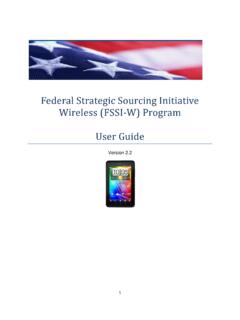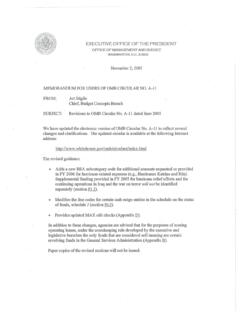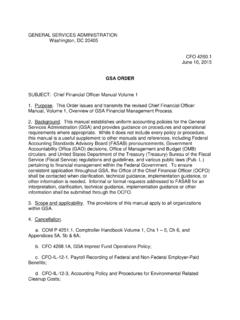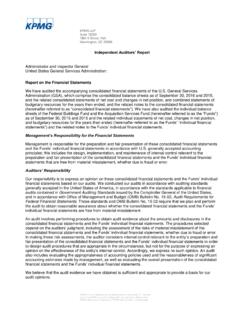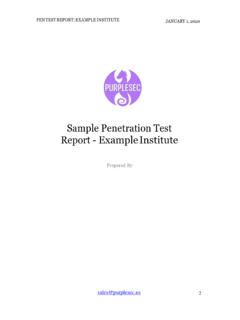Transcription of IT Security Procedural Guide: SSL/TLS Implementation CIO ...
1 Office of the Chief Information Security Officer Revision 4 May 26, 2020 IT Security Procedural guide : SSL/TLS Implementation CIO-IT Security -14-69 DocuSign Envelope ID: 3 EFE8B4E-8F68-4061-9154-FEB003A77A86 CIO-IT Security -14-69, Revision 4 SSL/TLS Implementation General Services Administration VERSION HISTORY/CHANGE RECORD Change Number Person Posting Change Change Reason for Change Page Number of Change Initial Version December 24, 2014 N/A ISE New guide created Revision 1 March 15, 2016 1 Salamon Administrative updates to align/reference to the current version of the GSA IT Security Policy and to CIO-IT Security -09-43, IT Security Procedural guide : Key Management Clarify relationship between this guide and CIO-IT Security -09-43 2-4 2 Berlas / Salamon Updated recommendation for obtaining and using certificates Clarification of requirements 7 3 Salamon Integrated with OMB M-15-13 and related TLS Implementation guidance New OMB Policy 9 4 Berlas / Salamon Updates to clarify TLS protocol recommendations Clarification of guidance 11-12 5 Berlas / Salamon Updated based on stakeholder review / input Stakeholder review / input Throughout 6 Klemens/ Cozart-Ramos Formatting, editing, review revisions Update to current format and style Throughout Revision 2 October 11.
2 2016 1 Berlas / Salamon Allow use of TLS for certain server through June 2018 Clarification of guidance Throughout Revision 3 April 30, 2018 1 Berlas / Salamon Remove RSA ciphers from approved cipher stack ROBOT vulnerability affected these ciphers 4-6 2 Berlas / Salamon Requirement for valid Subject Alternative Names (SAN) Chrome 58 requirement 7 3 Berlas / Salamon Remove 3 DES from approved cipher stack and reinforced other BOD 18-01 mandates BOD 18-01 mandated removal Throughout Revision 4 May 26, 2020 1 Richards Updated references and minor language clarifications Scheduled update Throughout 2 Richards Updated throughout for NIST SP 800-52 revision Scheduled update Throughout DocuSign Envelope ID: 3 EFE8B4E-8F68-4061-9154-FEB003A77A86 CIO-IT Security -14-69, Revision 4 SSL/TLS Implementation General Services Administration Approval IT Security Procedural guide : SSL/TLS Implementation guide CIO-IT Security -14-69, Revision 4 is hereby approved for distribution.
3 XBo BerlasChief Information Security Officer Contact: GSA Office of the Chief Information Security Officer (OCISO), Security Engineering Division (ISE) at DocuSign Envelope ID: 3 EFE8B4E-8F68-4061-9154-FEB003A77A86 CIO-IT Security -14-69, Revision 4 SSL/TLS Implementation General Services Administration i Table of Contents 1 Introduction .. 1 Purpose .. 2 Scope .. 2 2 Policy .. 2 3 Achieving FIPS 140-2 Compliant Encryption .. 3 Implement FIPS 140-2 Encryption Modules AND enable the FIPS 140-2 Object Module .. 4 Implement Secure Protocols .. 4 Implement FIPS-approved ciphers .. 5 Enable FIPS Mode .. 6 4 SSL/TLS Best Practices .. 7 Disable Client-Initiated Renegotiation .. 7 Disable TLS Compression .. 7 Ensure that the Server Certificate Is Valid, Secure, and from a Trusted Source.
4 7 Certificate Transparency .. 8 Ensure Sufficient Hostname Coverage .. 9 Protect Private Keys .. 9 Encrypt 100% of Site and Avoid Mixed Content .. 10 Disable Insecure HTTP Compression (if possible) .. 10 Implement TLS_FALLBACK_SCSV .. 10 Implement HTTP Strict Transport Security (HSTS) .. 11 5 Additional NIST SP 800-52 TLS Server Recommendations .. 11 All TLS Server Certificates Shall Be Version 3 Certificates .. 11 The TLS Server Should Not Support Client Certificate URL Extension .. 11 TLS Servers Supporting Client Authentication Shall Support Certificate-Based Client Authentication .. 12 NIST SP 800-52 Guidelines Shall Be Used to Identify an Appropriate Source for Server Certificates .. 12 Support for TLS .. 13 Only Support TLS if Required for Non-Government Users.
5 13 6 Assessment Resources for Web Servers .. 13 Appendix A Vendor References for TLS Settings .. 14 OpenSSL TLS Settings .. 14 Apache TLS Settings .. 14 Nginx TLS Settings .. 14 IIS TLS Settings .. 14 Appendix B Checklist of NIST SP 800-52 Recommendations .. 15 Recommendations for TLS Server Installation and Configuration .. 15 DocuSign Envelope ID: 3 EFE8B4E-8F68-4061-9154-FEB003A77A86 CIO-IT Security -14-69, Revision 4 SSL/TLS Implementation General Services Administration 1 1 Introduction The Transport Layer Security (TLS) protocol is used to secure communications in a wide variety of online transactions, including but not limited to financial ( , banking, trading stocks, e-commerce), healthcare ( , viewing medical records or scheduling medical appointments), and social ( , email or social media).
6 All network services, whether or not they handle Personally Identifiable Information (PII), financial data, and/or login information need to protect the confidentiality and integrity of the transmitted information. TLS provides a protected channel for sending data between a server and the client. The client is often, but not always, a web browser. TLS is based on an older protocol called Secure Sockets Layer (SSL), and is considered to be an improvement over its predecessor. While SSL is the most secure of the SSL protocol versions, it is not approved by the National Institute of Standards and Technologies (NIST) for use in the protection of federal information because it relies in part on the use of cryptographic algorithms that are not approved. TLS versions and are approved for the protection of federal information, when properly configured.
7 TLS version is approved only when it is required for interoperability with non-government systems and is configured according to these guidelines. TLS is a Security protocol that runs on top of a reliable transport layer protocol typically the Transmission Control Protocol (TCP). Application layer protocols such as the Hypertext Transfer Protocol (HTTP) and the Internet Message Access Protocol (IMAP) can leverage TLS. TLS is application independent and is used to provide Security for any two communicating applications that transmit data over a network via an application layer protocol. A virtual private network (VPN) can use TLS to securely connect an external system to an internal network, allowing that system to access a multitude of internal services and resources as if it were an internal system.
8 NIST Special Publication (SP) 800-52, Rev. 2, provides guidance for the selection and configuration of TLS protocol implementations while making effective use of Federal Information Processing Standards (FIPS) and NIST-recommended cryptographic algorithms. It requires that TLS configured with FIPS-based cipher suites be supported by all government TLS servers and clients. This Special Publication also provides guidance on certificates and TLS extensions that impact Security . Support for TLS is strongly recommended. 1 Agencies shall support TLS by January 1, 2024. After this date, servers shall support TLS for both government-only and citizen or business-facing applications. DocuSign Envelope ID: 3 EFE8B4E-8F68-4061-9154-FEB003A77A86 CIO-IT Security -14-69, Revision 4 SSL/TLS Implementation General Services Administration 2 Purpose The recommendations in this guide aim to facilitate more consistent and secure implementations of SSL/TLS throughout GSA applications and systems, including use of approved protocols, FIPS 140-22 validated cryptographic modules, FIPS-approved ciphers, and related configuration best practices.
9 This guide is not platform specific but instead provides a framework for testing web servers using SSL Labs to ensure secure SSL/TLS implementations. Scope This Implementation guide addresses both NIST and commercial best practice methodologies for securely configuring TLS, including the SSL Labs SSL and TLS Deployment Best Practices. Another industry best practice resource is the Open Web Application Security Project (OWASP) Transport Layer Protection Cheat Sheet. Additional TLS best practices are identified at the HTTPS-Only Standard site. Specific configuration information with related command-line switches for varying platforms is not provided as it is beyond the scope of this document. Please refer to Appendix A for vendor guidance in securing TLS implementations.
10 This document is a GSA Procedural guide that should be followed. Deviations from the SSL/TLS configuration herein shall be coordinated with the GSA Office of the Chief Information Security Officer (OCISO), Security Engineering Division. 2 Policy The following are applicable policy references from General Services Administration (GSA) Order CIO , GSA Information Technology (IT) Security Policy. Chapter 4: Policy for Protect Function 1. Identity management, authentication and access control. yy. Systems with a NIST SP 800-63-3 AAL of 2 or above used by Federal employees or contractors must accept Federal PIV cards and verify them IAW NIST SP 800-63-3 series requirements. 2. Awareness and training. s. Users must avoid prohibited Internet usages including: (7) Sending email messages including sensitive information, such as PII, as deemed by the Data Owner, without GSA provided encryption.
